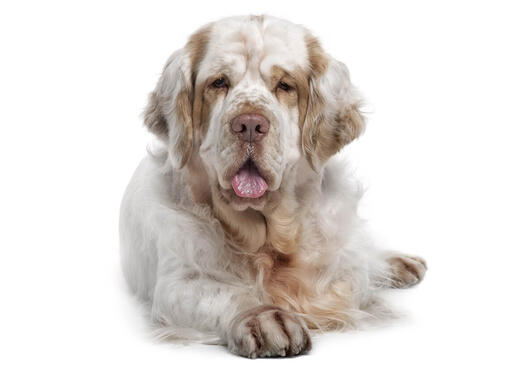
The Clumber Spaniel is an intelligent and determined dog with a long, low build and slow, rolling gait. The Clumber originated in 18th-century France where he was coveted for his superb hunting ability. Gentle, loyal and affectionate, the Clumber does well with families and other animals. He is enthusiastic about work and play. Clumbers prefer daily walks to heavy exercise. Their dense coats require daily brushing.
DID YOU KNOW? Though he was one of the first 10 breeds recognised by the American Kennel Club, the Clumber Spaniel is a rare breed in the U.S. today.
The need-to-know
- Dog suitable for owners with some experience
- Some training required
- Enjoys active walks
- Enjoys walking an hour a day
- Medium dog
- Heavy drool
- Requires grooming every other day
- Non hypoallergenic breedQuiet dog
- Not a guard dog
- Great with other pets
- Great family dog
Personality

The Clumber Spaniel being heavier built is slower to mature than other spaniels and generally steadier all round. They are a good natured, affable breed, dignified yet amusing and willing to do whatever task you take the time to teach them. As happy on the sofa as they are following a scent, the Clumber makes a devoted family dog.
History and Origins

Country of Origin: England
The Clumber Spaniel is another breed with somewhat vague romanticised origins involving French nobility, English Dukes and revolutions, however there is little evidence to support such ideas.The breed does owe their existence to the Duke of Newcastle and their name comes from his estate, Clumber Park where the Duke created his own particular type of heavy, steady Spaniel from the various hunting dogs available at the time. These may have included dogs imported from France, where notably, longer haired low slung ‘basset’ types were popular as these allowed huntsmen on foot to follow them without the need for horses.
Nutrition and Feeding

Large breed dogs, as well as having large appetites, benefit from a different balance of nutrients including minerals and vitamins compared to smaller-breed dogs.
Exercise

A strong, reliable recall is vital for off lead exercise, as whilst they are a slower moving Spaniel, they have considerable stamina and perseverance. Around an hour’s exercise per day with plenty of opportunity to enjoy finding scent and using their impressive nose will keep the Clumber Spaniel happy.
Other Information

Health and common issues
As with many breeds, the Clumber Spaniel can suffer from hereditary eye disorders, and hip dysplasia (a condition that can lead to mobility problems). Eye testing and hip scoring of dogs prior to breeding is therefore important. The breed club monitor the health of the breed carefully and should be contacted for the most up-to-date information and details of any DNA or additional testing they recommend. Breed Clubs can be found on the Kennel Club website.
Space requirements
The Clumber is a large dog on short legs, and this must be kept in mind when housing and buying equipment. Everything will be drooled on and coated in white hair! As with all low-slung dogs, whilst the Clumber Spaniel dries quickly and is easily brushed off, a sizeable quantity of mud and water can be gathered on paws and undercarriage. Suitable space to allow the Clumber to dry off after walks is necessary, but otherwise they are not hard to house. Providing a variety of interesting walks can be offered, the Clumber Spaniel can be happy in country or leafy suburb.
Training spaniel (clumber)
The Clumber Spaniel can be trained to a variety of activities and sports, particularly anything scent based, just remember they will do them at a slower, steadier pace than others. With the right understanding of what motivates him, and a ‘working together’ approach, the Clumber is easy to train and fun to spend time with. Teaching a recall is vital as the Clumbers excellent nose can otherwise lead him into trouble. As with all breeds who like to carry objects in their mouths, teaching a retrieve and swap game from a young age is important.
Best family dog breeds
The Clumber Spaniel is a steady and dependable character once adult; puppies of course can be more enthusiastic. As adults, this is a heavy breed so care should be taken with small children, those frail or unsteady on their feet and of course with smaller pets. While many dogs are traditionally thought of as being good with children, all dogs and children need to be taught to get on with and respect each other, and be safe together. Even so, dogs and young children should never be left alone together and adults should supervise all interactions between them.
Did you know?
- Prince Albert owned 7 Clumber Spaniels, and King Edward VII commissioned Faberge to carve a Clumber, ‘Sandringham Lucy’ from Chalcedony, with rubies set as eyes. This was purchased in 1909 by the then Prince of Wales (later King George V) for £102.
- While not quite as popular as they were in Victorian times, Clumber Spaniels still have their celebrity fans, with TV Chef James Martin having owned a Clumber named Fudge.
- Clumber Spaniel’s are seen in artwork as early as 1788, where they appeared with the Duke of Newcastle and his hunting party in Francis Wheatley’s painting, “The Return from Shooting”.
- The UK Kennel Club has deemed the Clumber Spaniel a vulnerable native breed and there’s less than 300 new dogs registered each year in the UK.
- The Clumber Spaniel was one of the first official breeds recognised by the American Kennel Club.